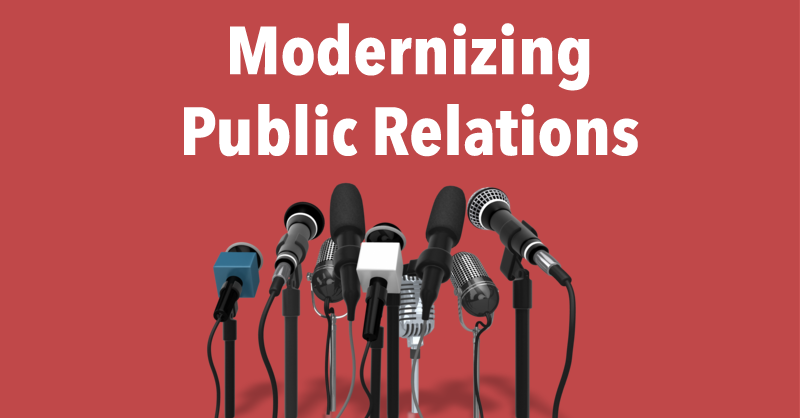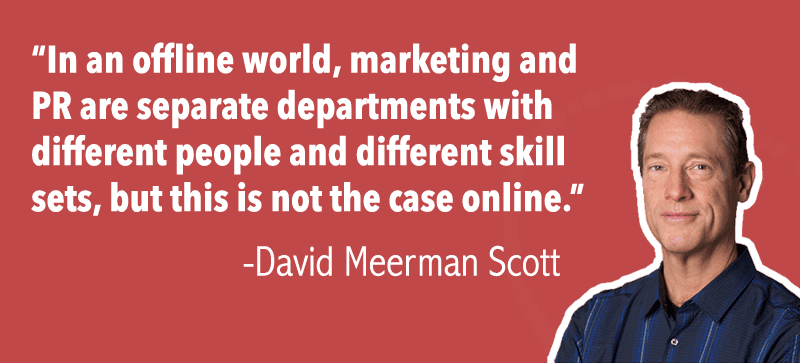
You’ve probably wondered whether focusing on public relations is still worth it today?
Absolutely, but not in the way you’re familar with.
Every week I get at least ten pitches emailed to me from different PR firms and consultants as they would like me to cover their client’s work on this blog or elsewhere.
98% of the time these media pitches are irrelevant to what I write about, templated as they are copied and pasted to multiple writers verbatim, super lengthy and convoluted or focused on awful products or services disguised as ground-breaking and innovative.
In a nutshell, these story pitches aren’t typically worth my time as a writer or yours as a reader.
I’m certainly not saying all PR firms and professionals are awful at their jobs, but many need a reality check to update their approach.
Why should you care? Because every terrible pitch sent to writers is paid for by companies hoping for coverage in the media and instead they are wasting their time and budget on outdated PR techniques.
Is this your organization? I hope not, but somebody is paying for it.
Either way, it is time to both hold the PR industry accountable for proliferating bad practices and for us as entrepreneurs and marketers to take the reigns and update the way we handle PR.
Public Relations is Always Changing
Public relations as a discipline has existed for a very long time, but probably not under a name you’d immediately recognize.
In an act of meta-PR genius, the entire field was renamed from its previous name: propaganda.
Referred to in his obituary as “the father of public relations,” Edward Bernays is the man with singular responsibility for both the name-change and the fundamental tenets of what he referred to as “the new propaganda.”
As he observed, propaganda got a bad rap after being used by the Germans in WWI. In his 1928 pamphlet “Propaganda,” Bernays outlined the fundamental tenets of the discipline and coined its new name.
Bernays realized that the emergence of mass media had given anyone with the will to use these tools (print, radio, television and now the internet) to persuade more people.
Advertisers began to subsidize media production, and in turn enjoyed the reach and publicity media afforded.
What public relations aimed to do, was to generate “free press” by engineering stories that would present value to the media, even if that value was non-monetary.
That’s where PR developed initially, but the problem today is that many PR firms and companies haven’t adapted their approach to modern times and still rely on the same techniques used a decade ago, which are far less effective.
We need to adapt to the fact that in the media landscape today there are more voices and platforms available to consumers, inundating them with lots of options as to where they can get information.
From Netflix to Snapchat, a consumer’s attention is split across more sources than ever before.
Not to mention, the attention span of consumers has fallen to about eight seconds illustrating that it’ll take an educational, entertaining and concise message to effectively reach someone.
Consumers are also more adverse to advertising of any sort today, which limits the effectiveness of a company or product being covered too promotionally in the media.
Journalists and other professionals in the media are facing the same problems.
It is harder for the media to maintain their audience with increased competition, which impacts the types of stories they are interested in covering.
Since consumer attention spans are low, it requires journalists to experiment with new storytelling approaches and formats, as well as the fact that they need to be more analytical than ever.
Journalists are obviously people too and thus also have a shorter attention span as well, making it all the more difficult today to have your stories stand out in their inbox.
And most of all, the journalists and the media at large also know that consumers have become more skilled at tuning out advertising and that becomes a problem as they try to find new ways to monetize.
Understanding the problems you’ll face from a PR perspective, as well as which issues plague the media is the first step towards crafting a more effective PR strategy.
According to David Meerman Scott, marketing strategist and author of The New Rules of Marketing and PR, “There is a fundamental truth that most communicators fail to understand about a successful online strategy to reach buyers directly: The convergence of marketing and PR,” he said.
“In an offline world, marketing and PR are separate departments with different people and different skill sets, but this is not the case online,” he added.

“When a buyer is researching your product category by using a search engine, does it really matter if the first exposure is your website, a news release your organization sent, a magazine article or a post on your blog? I’d argue that it doesn’t matter.”
“Great content in all forms helps buyers see that you and your organization get it. Content drives action,” said Scott.
Learn how to modernize the use of PR at your organization by integrating it with content marketing to solve for existing challenges in the market and generate the coverage you’ve been looking for.
Five-Approaches to Integrating Content Marketing and Public Relations
Content marketing is successful at reaching audiences because it allows your organization to provide value and utility in a non-disruptive way and in return builds trust, start conversations about your brand, drives leads and can even help generate additional coverage in the media.
1. Before pitching the media, start creating content that articulates your storyline.
Hold off on pitching your products and services to blogs and publications at first and instead develop a content marketing strategy to outline how you’ll create content that will clarify what your company’s story is.
The story shouldn’t be fabricated, but instead reflect the reasons why your company exists in the first place — your purpose as an organization.
For example, retailer Warby Parker’s reason for existing is to take on the eyeglasses giant Luxottica that holds a monopoly over the industry, make it easier to shop for glasses online, offer more affordable and stylish eyewear and give back to underserved communities in the process.
The company focused their content and all messaging with the press around these themes, which made it far more interesting to cover than if they pitched the media to early and focused the pitch on the details of their products like the frame sizes or other features about their offerings.
A content strategy will help address the types of content to create for your audience, based on your research, as well as the topics and themes to regularly address with content.
Whether you’re writing blog posts or producing a podcast, taking this valuable time to map out what your plan of action is will better prepare you to share your stories with the media.
Beyond the additional knowledge you’re collecting on your audience by researching your content strategy, the content you’re creating can actually be used within your pitches.
Writers at the blogs you’ll pitch to aren’t likely excited about the launch of your new product, but if you’re showing them the value and the story behind what you’re doing with relevant content as opposed to telling them how great it is, you’re far more likely to spur their interest.
And like David Meerman Scott said earlier, it doesn’t matter if a customer discovers your organization through a blog post, podcast interview or an article in the media as long as it builds trust with them.
As you’re developing content, think about how this content could be included within a pitch to the media to support what you’re sharing with a journalist as well as how the content itself might be covered by the media.
2. Reassess why and how you’re pitching the media.
When constructing a pitch to the media today it is essential that you’re following these guidelines, some of which are old school rules that will never change and others are new considerations:
- When possible, develop relationships with writers ahead of pitching them a story to build an ongoing rapport with the media professionals most active in your industry. Take them to lunch, coffee, say hello over email or get creative about how you can add value.
- Do your research and find the first name of the reporter or journalist you’re trying to pitch over email, personalization is vital to the pitch’s success.
- Consider pitching over the phone, texting, social media or elsewhere that’s less inundated with other messages as long as they don’t have a note specifically saying not to pitch them there.
- Review each publication you’re pitching to see if they’ve covered a similar topic to your pitch before and if they are targeting the same audience you’d like to reach based on the themes and topics they are covering.
- Take a look at the past articles and social media feeds of the writers you’re pitching to understand what they are looking for and what interests them. Reviewing the tweets and posts of a journalist will showcase the topics they are passionate about, as well as provide insight into better personalizing the pitch.
- Include your name, title and the company you work for in two sentences or less to frame who you are and your connection to what you’re pitching.
- Add the actual story idea you’d like them to consider in no more than three to four sentences, link to an item or two of content to support the pitch and provide depth on the subject if they are interested.
- Never copy and paste a pitch, but instead customize it to each writer as any pitch that feels like a template will be ignored.
- The subject line of the email should be descriptive and concise as possible to get the editors attention. My advice is to not overthink it.
- When possible, include links to existing coverage of the campaign, product or service in another publication to increase the likelihood they’ll cover the story to compete with another site.
- Don’t pitch something you don’t believe in as no one else will either. Creating coverage for a terrible product disguised as something useful will do more harm than good for your reputation.
- Only follow-up on your pitch twice, other than that you’re being annoying to the writer who likely saw the email or message and decided they didn’t want to move forward.
- Add personality whenever possible to make the editor laugh, understand your passion on the subject or be intrigued by the story. Often a writer wants to learn, not be convinced.
- Think about the timeliness of the pitch, ask yourself whether your topic ties into current events.
- Is your pitch location specific or is it a broader story? If your story is locally focused, consider local papers and blogs over a larger outlet.
- Expand beyond pitching to blogs and publications, start pitching your stories to relevant and popular podcasts, YouTube channels, email newsletters and other mediums that may have similar reach as some publications, but with less pitches sent to them on a regular basis giving you a better chance to stand out.
3. Encourage staff to contribute to industry blogs and publications.
Content marketing is highly effective at building trust with your intended audience. One way to establish trust with your customer base, as well as additional visibility in the media, is by working with your team to contribute articles to industry publications (also known as guest blogging).
Developing columns in publications and blogs allows your team to write and distribute articles that showcase their expertise, interest in adding to industry discourse, drives links to your website and generates visibility of the company’s brand, as well as the personal brands of each contributor.
For instance, if you were a yoga apparel company, it’d be advantageous to have your leadership contribute articles to websites like MindBodyGreen, Greatist or Yoga Basics.
PR professionals and firms should train company leadership and other staff members on how to pitch ideas for articles they’d like to write to publications that serve their audience.
With an increasing number of voices and platforms to compete with today, relying on coverage by the media alone won’t be enough to drive the visibility you’re looking for.
By having your team share content through a variety of reputable publications and blogs you’ll have another opportunity to increase your company’s profile online.
4. Diversify by going niche. Don’t be afraid to experiment.
As consumer attention continues to splinter across different screens and apps, this requires coverage of your organization in a diverse range of media outlets.
Your organization should not only pitch and build relationships with journalists at traditional news outlets, but also focus on different media channels, local publications and blogs.
Don’t hesitate to pitch your company’s stories and content to relevant podcasts, radio stations, YouTube channels, email lists and elsewhere that cover your industry or similar topics.
In addition, target publications and blogs with a local, regional and national focus to vary where your company generates coverage, links and visibility in relevant markets.
For example, Car2Go’s debut in Brooklyn and Queens was widely covered by local blogs like New York Daily News and Crains as some of these outlets were likely pitched to take a test drive, while other articles were paid for by the company as sponsored posts to spur coverage in Brokelyn and Brooklyn Based.
Something to consider with going after local coverage is that it is easier to land than national or large-scale publications and blogs as they have a smaller pool of stories to pull from and are more likely to read and accept your pitch.
Once you do get coverage on a niche local blog, use this new story as a reference point when pitching publications and blogs that have larger audiences and exposure.
This is a technique I learned from author Ryan Holiday’s book Trust Me, I’m Lying: Confessions of a Media Manipulator, but unlike certain accounts from the author, I’m only suggesting you pitch factual stories about your business.
It appears that niche blogs that cover the automotive industry were also pitched to cover Car2Go’s launch like Auto Blog and Autos CheetSheet.
Car2Go’s campaign is the ideal example of diversifying where content is created about your business as you aim to develop consistent conversation around a campaign or product.
The company wasn’t afraid to experiment and take a mixed approached by pitching their story to local and niche blogs as well as paying for sponsored content (either created by the publication for the brand or co-created by the brand and publication).
The key here was to be repeatedly covered in all different types of publications to deal with the fact attention spans are short, so it’ll likely take multiple instances of exposure with a brand online and offline before a consumer takes notice.
5. Drop the promotional push with your PR and instead focus on adding value.
Your PR and content efforts will be ignored if they appear too promotional or disruptive to consumers as they are looking to receive value from your communications, not a sales pitch.
To create worthwhile press releases, pitches to editors, blog posts, events or other formats of content that generate the right visibility for your enterprise, it needs to be focused on one of the following value-centric elements:
- Illustrating the reasons why your organization exists in the first place through storytelling. For example, if you were a paper printing company focused on making the industry more eco-friendly, then it’d be advantageous to share stories on how you’re making that happen, whether through volunteering, alternative manufacturing practices etc.
- Teach consumers something new and original. Buck industry standards and disrupt myths with new facts, figures, statistics and approaches to way things have always been done by consumers. Changing people’s minds on a subject improves the likelihood they’ll remember your company and its products in the future.
- Solve a meaningful problem for consumers with your product or service showcased with examples of your company’s offerings in action and their impact. This doesn’t mean your product needs to solve world hunger, but it does mean you need to make life easier for a large group of consumers like what Joy Mangano’s Miracle Mop did for millions of households across America.
- Humanize the brand by sharing stories of your staff, customers and partners and how the company and its services have impacted them positively. Showcasing the individuals behind the organization makes it far more relatable as does understanding how other customers use a company’s products and services.
- Spur calculated controversy to stir up conversation, but tread lightly. Sensitive subjects, especially when timely, can lead to lots of heated discussions online as they trigger emotional responses from people and if done correctly can generate widespread visibility like the Abodo campaign did.
For example, Abodo, an apartment listing website, created a resource using Twitter data to identify the states and cities with the most prejudiced and tolerant tweets in America.
This is obviously a very sensitive subject and unfortunately timely in the U.S., so it resonated quickly on social media and generated widespread media coverage (over 600 links) as it was original, controversial information and was pitched to multiple publications from different angles.
According to the Moz case study on the campaign, Abodo felt that this data would be another indicator for their customers to use to decide where they want to live and they would purposely not draw conclusions and let the data speak for itself.
This is why the campaign was not only a success from a PR and content perspective, but it also didn’t hurt their reputation or offend their customers. The campaign didn’t overtly promote Abodo, but instead discussed a controversial subject, related to the services the website offers.
Content can help rejuvenate your approach to public relations, but only if you’re willing to update your mindset to move beyond traditional tactics to reach the modern consumer.
What PR and content marketing strategies have you successfully integrated to generate visibility for your company? What are some of your favorite examples from other organizations mixing PR and content marketing? Share your experiences and examples in the comments below.


